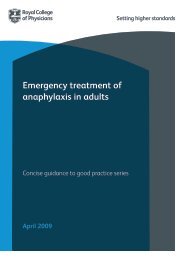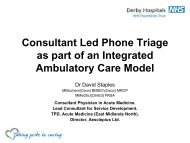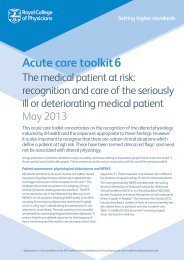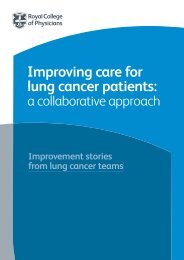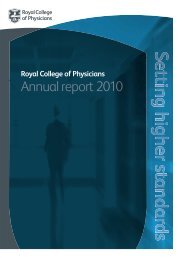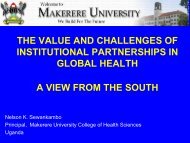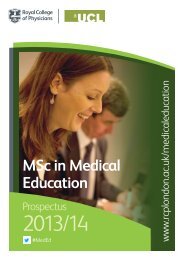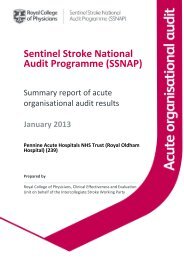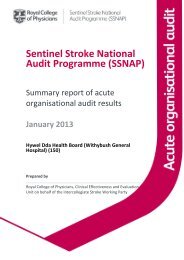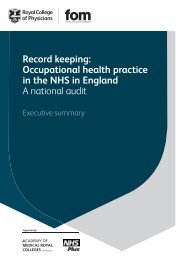Consultant physicians working with patients - Royal College of ...
Consultant physicians working with patients - Royal College of ...
Consultant physicians working with patients - Royal College of ...
Create successful ePaper yourself
Turn your PDF publications into a flip-book with our unique Google optimized e-Paper software.
<strong>Consultant</strong> <strong>physicians</strong> <strong>working</strong> <strong>with</strong> <strong>patients</strong> Pulmonary vascular disease: thisisorganisedonasupra-regional basis, and all seven centres (six inEngland and one in Scotland) have been approvedby the National Specialist Commissioning AdvisoryGroup (NSCAG) or National Services Division(NSD) in Scotland. All centres have at least twoconsultants trained in pulmonary vascular diseasewhowillbeabletocommitupto50%<strong>of</strong>theirtimeto the specialty. Occupational lung diseases: consultants who work insuch units will receive many tertiary referrals andwill require at least 3–5 PAs per week for thiscomplex work.7 Opportunities for integratedrespiratory careAlthough respiratory medicine provides a mainlyhospital-based service, job patterns involvingcommunity work are increasingly being developed, andconsultants in integrated respiratory care, who havesessions both <strong>with</strong>in a hospital and in the widercommunity, have been appointed in some areas.Examples <strong>of</strong> community work include: development <strong>of</strong> care pathways to facilitate care closerto home clinical leadership for integrated respiratory careservices to ensure excellent multidisciplinary clinicalcare across the whole pathway leading local respiratory networks education <strong>of</strong> primary and intermediate carehealthcare pr<strong>of</strong>essionals medical input into pulmonary rehabilitation,respiratory nursing services and hospital-at-homeand outreach services clinics in a non-hospital-based setting clinical responsibility for high-quality lung functionand oxygen assessment services assessing and managing <strong>patients</strong> <strong>with</strong> complexbreathlessness in the community promotion <strong>of</strong> better end-<strong>of</strong>-life care for those <strong>with</strong>severe lung disease.8 Workforce requirements forthe specialtyTo provide a high-quality, patient-centred, specialistrespiratory service, as described above, a DGH thatserves a population <strong>of</strong> 250,000 people requires 7 WTEadult respiratory <strong>physicians</strong>, equating to 1,428 WTEs inEngland. This assumes that they also undertake on-callwork, are adequately supported by a team <strong>of</strong> otherrespiratory pr<strong>of</strong>essionals, have adequate facilities andresources, and work under a direct clinical contract <strong>of</strong>7.5PAs.Manyunitsfallwellshort<strong>of</strong>thisnumber.Withdemands for a consultant-led and -delivered service,pressures from the European Working Time Directive,an ageing population and the changing <strong>working</strong>patterns <strong>of</strong> consultants (<strong>with</strong> more opting to work lessthan full time), it is estimated that 1.4 consultants willbe required to replace every one current WTE in futureyears.In November 2012, 976 consultants were <strong>working</strong> inrespiratory medicine in England and, despite financialpressures, the numbers <strong>of</strong> respiratory consultants hascontinued to increase. In the last quarter <strong>of</strong> 2012 therewere 641 respiratory trainees in England, roughly half <strong>of</strong>whom are female; 104 <strong>of</strong> these trainees were out <strong>of</strong>programme (OOP) at that time. Training programmedirectors and others continue to actively support OOPactivity, but it is increasingly difficult to fill gaps thatthen remain in training programmes <strong>with</strong> LAT (locumappointment – training) doctors (only 12% <strong>of</strong>respiratory LAT posts were filled in 2012). In contrast tosome other specialties, <strong>with</strong> the feminisation <strong>of</strong> theworkforce, there has been little increase in thenumbers <strong>of</strong> trainees or consultants <strong>working</strong> less thanfull time.Respiratory <strong>physicians</strong> who responded to the RCP’scensus in September 2011 were contracted for anaverage <strong>of</strong> 10.8 PAs, but worked an average <strong>of</strong> 12 PAs perweek, the vast majority <strong>of</strong> which were clinical. 10 Withchanges in <strong>working</strong> patterns and the move toconsultant-delivered service, it seems that consultantexpansion needs to continue for several years to come,albeit at a slower rate than we have seen in recentyears.9 <strong>Consultant</strong> work programme/specimenjob planThe 10-PA job plan shown in Table 2 assumes that thecorrect number <strong>of</strong> WTE consultants is employed in thedepartment. As respiratory services are delivered byteams, individualised job plans – in terms <strong>of</strong> bothcontent and number <strong>of</strong> PAs worked – can easily beadapted from the 10-PA job plan on a proportionalbasis to accommodate flexible <strong>working</strong>.232 C○ <strong>Royal</strong> <strong>College</strong> <strong>of</strong> Physicians 2013



